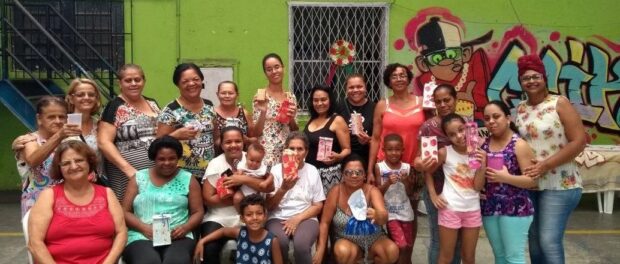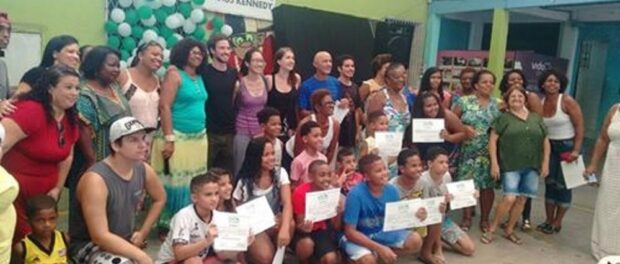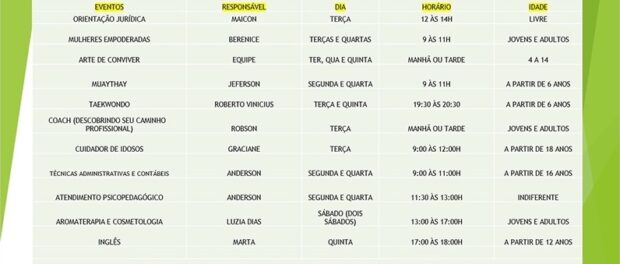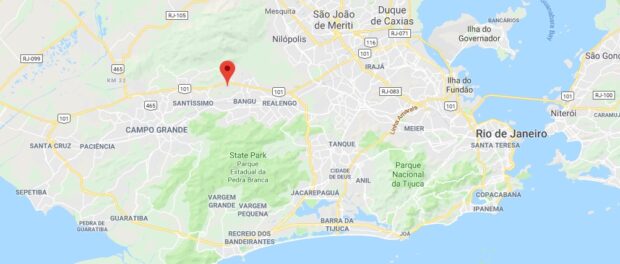
Initiative: The Kennedy Brothers Community Center (Centro Comunitário Irmãos Kennedy – CCIK)
Contact: Facebook | Email
Year Founded: 1969 / 2010
Community: Vila Kennedy
Mission: The Kennedy Brothers Community Center is a nonprofit association managed by volunteers with the objective of carrying out social projects to improve, empower, and provide opportunities for the community.
Public Events: A schedule of CCIK’s weekly events and course offerings can be found on its Facebook page.
How to Contribute: The CCIK is seeking financial partnerships to sustain its volunteer workforce. It also welcomes volunteers with expertise to instruct existing courses or offer new ones. The center specifically needs volunteers to provide support with graphic design and the creation of a website.
Vila Kennedy, in Rio’s West Zone, has faced its share of challenges in 2018, ranging from local kiosk evictions to destructive rains and a heightened police presence. But on a Saturday morning in late April, a celebration nonetheless took place at The Kennedy Brothers Community Center (CCIK). With nearly a dozen volunteers and virtually no financial resources, the CCIK celebrated its 49th birthday and the graduation of students in its first semester of courses and activities—which included children’s taekwondo, English classes, administrative job training, and caring for seniors. Following the ceremony, kids swarmed a snack table displaying the center’s birthday cakes, while CCIK participants of all ages posed for photos with their diplomas.
Distributing course certificates—and running the community center itself—was Verônica Gomes Martins da Silva, a social worker who was born and raised in Vila Kennedy. She began volunteering at the CCIK in 2010, when the space transitioned from a community nursery (founded by Catholic nuns in 1969) to the center that it is today. Gomes has participated in social projects in the community throughout her life—her mother worked at the nursery, and Gomes spent free time there in her youth. It is only fitting that she is now the Director-President of the same space—one that has provided services to over 10,000 people since 2010, according to Gomes. “I could be working anywhere else,” she says with a smile, “but my heart is here.”
The CCIK provides a wide range of weekly activities and classes: basketball and music classes for kids, women’s empowerment conversation groups, pro bono legal advice, psychological support, social services, and work training programs (including administration, human resources, and handicraft workshops) with municipal partners such as SENAC and SESC.
“Today the community center makes a big difference; it directly impacts the lives of [community] residents. We know this,” says Gomes. On average, the center offers monthly services to more than 200 people. For each course offered, the CCIK receives about 70-80 registrations, a demand that exceeds available resources. For example, 32 students are actively enrolled in the English course, while another 40 students are on the waiting list. Likewise, approximately 25 students are enrolled in the taekwondo class, for which over 50 registered.
Despite its achievements, Gomes does not tiptoe around the struggles of running a not-for-profit organization. “It is a very big challenge, making the community center a point of reference in this area… It’s really hard to do social work without any resources,” she says. While the center has formed partnerships across the city, financial support is nearly impossible to come by. Gomes holds other jobs in order to continue volunteering as director, and none of the other ten volunteers are financially compensated for their work—something that she wants to change to “show the volunteers that we have today how much we value them.”
Through her work with the CCIK, Gomes has learned that change doesn’t happen overnight. “When you arrive… at a social project, you want to do something, [you want] something to happen [immediately].” In reality, she has found, the process is more complicated: you discover the need to plan, to organize, to make schedules. “And this all happens much more slowly.” This explains why, on the one hand, she describes an ideal vision of a “revitalized community center, updates made, with many more partnerships… if we want to dream.” On the other hand, she describes a more structured goal of “advancing… in a conscious way” to “gain financial support so that we can actually achieve everything that we need today.” Both visions are necessary for the CCIK to achieve its goals.
Beyond the issue of funding, Gomes identifies two major challenges of working in Vila Kennedy. The first is the community’s security situation, which “ended up fragmenting our actions a bit,” she says. Insecurity has “demotivated partnerships,” taking away opportunities to attract partners and volunteers from other parts of the city. “It’s one more thing that you lose,” she says. This makes the center’s work more difficult, but also more necessary. Gomes says she can see the positive impact of events and courses held at the center for people who have become afraid to leave their homes. She also sees the effects of creating a secure space for children who “don’t have anything else to do. If we let them, they would spend the whole day here.”
The second challenge? Trash: an issue that Gomes calls “gigantic.” In response, the CCIK has developed projects aimed at raising environmental awareness. Gomes contends that the problem is “not one of trash collection,” which she says is excellent, but a “cultural question, one of education.” She explains that many residents do not realize that they need to leave trash in a specific place in order for the city to collect it; rather, they often leave trash at the doors of schools and nurseries, according to Gomes. The CCIK has partnered with other community groups to educate residents on this process. Furthermore, the center offers activities such as its upcoming community garden, in addition to a project that recycles unused cooking oil into products such as soap. “The environmental question,” Gomes says, “we are starting [to deal with it].”
Despite these challenges, Gomes is motivated by a sense of optimism. “I believe in people,” she says. She emphasizes that “the history of Vila Kennedy is a really beautiful story, thanks to all of the social and cultural movements here. I believe that we need to revive these movements because the story has been reversed” in recent years. But, Gomes continues, “We have a legacy, a marvellous cultural history here. We have poets, artists; we have a theater… We have this wealth.” She begins to list social projects in the area, from the community nursery that predates the CCIK to the local health clinic that has partnered with the CCIK in service provision.
“We have a lot of young people who sometimes go through many negative things,” Gomes explains, “but we have brilliant young people… Kids who study, who dream… There are so many positive things that we have to show…. [and] we have to show what we have.” This is especially true in a volunteer-run center: Gomes knows how important it is for people to see and believe in what they are doing. She calls it a “question of reciprocity: that you contribute if you believe… in the transformation of the space.”
Gomes says that the center’s work continues because “people come, get to know [our work], and want to help us.” She calls it “striking”—and surprising, too—that people arrive at the center and not only stay but become more involved because they “fall in love with our work.” She describes the center “causing this…emotion, this question—this feeling of belonging, of responsibility.” From that feeling comes a desire to improve the center, and the community itself.
In the short-term, Gomes says that upcoming projects include a community garden, a candy shop, and a partnership to offer a new course entitled “The Art of Living” for children aged four to fourteen years old. More broadly, the community center is working to increase its visibility across Vila Kennedy and in the West Zone. While the space has existed for almost 50 years, it has only functioned as a community center for the past eight.
It is hard work, but Gomes knows it’s worthwhile. When heavy rains left the community center “full of mud,” everyone pitched in to help, telling Gomes that “this space here is ours.” Everything at the center is done collectively because “people feel they are a part of the space… The meetings, the plans, [are] made in a participatory way, always with the volunteers….If we didn’t, this wouldn’t work. I depend on every single person here to keep this work going.”
*The CCIK is one of over 100 community projects mapped by Catalytic Communities (CatComm), the organization that publishes RioOnWatch, as part of our parallel ‘Sustainable Favela Network‘ program launched in 2017 to recognize, support, strengthen, and expand on the sustainable qualities and community movements inherent to Rio de Janeiro’s favela communities. Check out all the profiles of mapped projects here.



